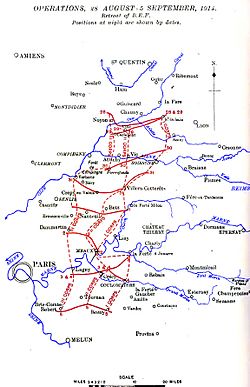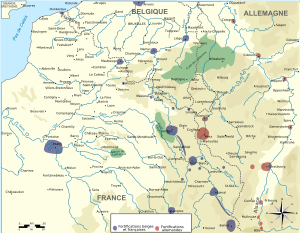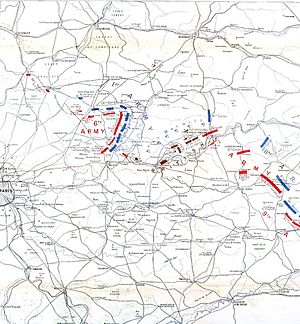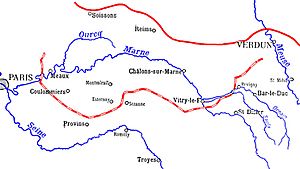Great Retreat facts for kids
Quick facts for kids Great Retreat |
|||||||||
|---|---|---|---|---|---|---|---|---|---|
| Part of the Western Front of the First World War | |||||||||
 British retreat, 24 August – 5 September |
|||||||||
|
|||||||||
| Belligerents | |||||||||
| Commanders and leaders | |||||||||
The Great Retreat was a major military withdrawal that happened in August and September 1914. It involved the British Expeditionary Force (BEF) and the French Fifth Army. They had to pull back a long way to the River Marne in France.
This retreat happened because German armies had defeated the British and French forces. These battles took place at Charleroi (August 21) and Mons (August 23). The French Fifth Army tried to fight back at the First Battle of Guise (August 29–30), but it didn't stop the Germans. The retreat continued.
However, from September 5 to 12, the First Battle of the Marne finally stopped the Allied forces' retreat. It forced the German armies to go back towards the Aisne River. This led to the First Battle of the Aisne (September 13–28). After that, both sides tried to get around each other's armies to the north. This period is known as the Race to the Sea (September 17 to October 17).
Background to the Great Retreat
Battles at the Borders (August–September 1914)
The "Battle of the Frontiers" is a general name for all the early battles fought by the French armies. These battles happened between German, French, and Belgian armies. They took place along the German-French border and in southern Belgium starting on August 4, 1914.
The first French attack of World War I was the Battle of Mulhouse (August 7–10). The French took Mulhouse but were soon pushed out by a German counter-attack. They had to fall back.
The main French attack, the Battle of Lorraine (August 14–25), began with the Battles of Morhange and Sarrebourg. The French First and Second Armies advanced. But the German 6th and 7th armies fought back on August 20. The French armies were forced to retreat. The Germans then crossed the border and moved towards Nancy, but they were stopped.
Further south, the French briefly retook Mulhouse on August 19, then pulled back again. In the Vosges mountains, a small German attack was made at the Battle of the Mortagne (August 14–25). The Germans gained a little ground, but a French counter-attack took it back.
By August 20, a German counter-attack in Lorraine had started. The German 4th and 5th Armies moved through the Ardennes forest towards Neufchâteau. The French Third and Fourth armies also attacked through the Ardennes on August 20. They were trying to help the French invasion of Lorraine. The armies met in thick fog. The French thought the German troops were just small scouting groups.
On August 22, the Battle of the Ardennes (August 21–28) began. French attacks were very costly for both sides. The French were forced into a messy retreat on August 23. The Third Army went back towards Verdun, and the Fourth Army retreated to Sedan. Mulhouse was captured again by German forces. The Battle of the Meuse (August 26–28) temporarily stopped the German advance.
Liège in Belgium was taken by the Germans on August 7. The first British troops landed in France. On August 12, the Battle of Haelen was fought. It was a success for the Belgian defense. The British Expeditionary Force (BEF) finished moving its troops to France by August 16. The Belgian government left Brussels on August 18. The German army attacked the Belgian army at the Battle of the Gete. The next day, the Belgian army began to retreat towards Antwerp. This left the way to Namur open. Longwy and Namur were surrounded by August 20.
Further west, the French Fifth Army had gathered along the Sambre River by August 20. They faced north, near Charleroi and the Belgian fortress of Namur. On their left, the French Cavalry Corps connected with the BEF at Mons.
Key Battles Before the Retreat
Battle of Charleroi (August 21)
By August 20, the French Fifth Army was spread out along a 40 km (25 mi) front. This line was centered on Charleroi and stretched east to the Belgian fortress of Namur. On the left side, the French cavalry linked up with the British Expeditionary Force (BEF) at Mons.
General Joseph Joffre ordered the French commander, Lanrezac, to attack across the Sambre River. But the German 2nd Army attacked first on the morning of August 21. They crossed the Sambre and set up two bridgeheads (areas on the other side of the river). The French didn't have enough artillery to push them back.
The Germans attacked again on August 22 with three army groups against the entire French Fifth Army. Fighting continued on August 23. The French center around Charleroi began to fall back. The German 3rd Army crossed the Meuse River and attacked the French right side. The French stopped this attack and fought back. The Fifth Army was now facing German armies from both the east and the north. To avoid being surrounded, the Fifth Army began to retreat southwards on August 23.
Battle of Mons (August 23)
The Battle of Mons was a smaller part of the larger "Battle of the Frontiers." Here, the British Expeditionary Force (BEF) tried to hold a line along the Mons–Condé Canal against the advancing German 1st Army.
On August 23, the Germans focused their attack on the British at a bend in the canal. At 9:00 a.m., the Germans tried to cross four bridges over the canal. By the afternoon, the British position became impossible to hold. To the east, German troops had begun to cross the canal, threatening the British right side.
At 3:00 p.m., the British 3rd Division was ordered to pull back from the bend. A retreat was ordered for the 5th Division by evening. By nightfall, the British had set up a new defensive line. The Germans built temporary bridges and were approaching the British in large numbers. By nightfall on August 24, the British had retreated further. They were outnumbered by the German 1st Army, and the French Fifth Army was also falling back. The BEF continued to retreat. The British suffered 1,642 casualties, while the Germans had 2,000.
The Retreat Continues (August 24 – September 1)
Battle of Le Cateau
On the evening of August 25, British General Horace Smith-Dorrien ordered his troops to stop and fight. He wanted to deliver a "stopping blow" to the Germans. The Allies set up defenses near the town of Le Cateau. Since another British army group had not arrived, Smith-Dorrien's right side was unprotected.
On the morning of August 26, the Germans attacked with two infantry and three cavalry divisions. The British had three infantry divisions, an infantry brigade, and a cavalry division. Out of 40,000 Allied soldiers fighting at Le Cateau, 5,212 were killed or wounded. About 2,600 troops were captured, and 38 British guns were lost. The Germans suffered 2,900 casualties. As the British continued their retreat south towards Paris, there were small, strong holding actions by various British units protecting the rear.
Rearguard Actions and Skirmishes
After the battles from August 21–24, the German 2nd Army commander, General Karl von Bülow, ordered a fast chase. The German 1st and 2nd armies were sent southwest to get around the left side of the Allied line.
There were several smaller fights where British and French troops tried to slow down the German advance:
- Le Grand Fayt: On August 26, the 2nd Connaught Rangers, a British unit, was covering the retreat of another brigade. They came under heavy German fire and had to retreat in an orderly way, even though many men were lost.
- Étreux: On August 27, the 2nd Royal Munster Fusiliers, a British battalion, was ordered to hold their ground at all costs. They were greatly outnumbered but fought bravely until they ran out of ammunition and surrendered. This action bought valuable time for the main British force to escape.
- Cerizy: On August 28, British cavalry engaged German cavalry near Cerizy. The British cavalry charged and caused many German casualties, forcing them to retreat.
- Néry: On September 1, in a thick fog, a British cavalry brigade was surprised and attacked by a German cavalry division. Both sides fought dismounted (off their horses). British artillery was mostly knocked out, but one gun kept firing for two and a half hours against 12 German guns. British reinforcements arrived and helped push back the German attack. The Germans lost many men and left eight guns behind.
- Crépy-en-Valois and Villers-Cotterêts: German air scouts saw British troops retreating towards these towns on August 31. The Germans tried to trap the British rearguards, but the British managed to slip away. There was heavy fighting, including hand-to-hand combat, as the British slowly pulled back.
Battle of St. Quentin (August 29–30)
General Joffre ordered the French Fifth Army to counter-attack at St. Quentin on August 29. However, a copy of the orders fell into German hands, giving the Germans time to prepare.
The French attacks on the town were costly failures. But on the right side, some French units pushed forward and forced the Germans near Guise to fall back. The French attacked again on the morning of August 30, but their attacks were not well-coordinated and were pushed back. The Germans counter-attacked before noon.
German infantry made slow progress through the Oise marshes, with heavy artillery fire from both sides. By early afternoon, air reports showed that the French had begun to withdraw. The German commander, Bülow, ordered a pursuit by small groups, while the main force rested. The French Fifth Army continued its retreat to the Marne River on August 31.
After the Retreat
Advance to the Aisne (September 6 – October 1)
First Battle of the Marne
General Joffre used the railway lines to move French troops from Lorraine and Alsace. He formed a new Sixth Army near Paris. By September 10, many divisions had been moved west. This changed the balance of power between the German and Allied armies.
On September 4, Joffre ordered the Sixth Army to attack eastwards. The British Expeditionary Force (BEF) was to advance, and the French Fifth Army was to attack northwards. The French armies further east were to resist German attacks.
On September 5, the Sixth Army advanced from Paris against a German army group. The French were stopped just short of high ground. Overnight, the Germans pulled back to a better position. German air scouts saw German forces moving north to face the Sixth Army. The German 1st Army commander, General Alexander von Kluck, ordered his troops to move to the north bank of the Marne River. This move prevented the Sixth Army from crossing the Ourcq River. But it created a gap between the German 1st and 2nd Armies.
The BEF advanced from September 6–8. They crossed the Petit Morin River and captured bridges over the Marne. The French Fifth Army also advanced into the gap. By September 8, they crossed the Petit Morin, forcing the German 2nd Army to withdraw. The next day, the French Fifth Army re-crossed the Marne. The German 1st and 2nd armies began to retreat. The French Ninth, Fourth, and Third armies fought defensive battles against the German 3rd Army, which was also forced to retreat on September 9.
| Month | No. |
|---|---|
| August | 14,409 |
| September | 15,189 |
Further east, the French Third Army was pushed back. German attacks were made on the Meuse Heights, but the French managed to stay connected with Verdun. German attacks against the French Second Army almost forced them to retreat, but the situation eased by September 8.
By September 10, the German armies west of Verdun were retreating towards the Aisne River. The French and British followed them, collecting lost soldiers and equipment. On September 12, Joffre ordered a move to get around the German armies from the west. However, the pursuit was too slow. By September 14, the German armies had dug in north of the Aisne. The Allies found trench lines instead of just small rearguard groups. Attacks by the French armies were pushed back on September 15–16. This led Joffre to start moving the French Second Army west. This was the first step in trying to get around the German armies. From September 17 to October 17, both sides tried to outflank each other, moving through Picardy and Flanders towards the North Sea coast.
First Battle of the Aisne
On September 10, Joffre ordered the French armies and the BEF to take advantage of their victory at the Marne. For four days, the armies on the left side advanced against German rearguards. On September 11 and 12, Joffre ordered flanking moves, but the advance was too slow to catch the Germans. The Germans ended their withdrawal on September 14.
The Germans reached high ground on the north bank of the Aisne River and began to dig in. This limited the French advance from September 15–16 to only a few small gains. French troops had started moving west on September 2, using undamaged railway lines behind their front. This allowed them to move troops quickly.
On September 17, the French Sixth Army attacked from Soissons to Noyon. This was the westernmost point of the French line. The fighting then moved north to Lassigny, and the French dug in around Nampcel.
The French Second Army finished moving from the east end of the French line. They took command of the left side of the Sixth Army. This happened as there were signs that German troops were also being moved from their eastern side. A German army group arrived from Belgium on September 16. It joined the German 1st Army for an attack to the southwest. This was against the French attempt to get around their flank. The attack was canceled, and the German troops were ordered to pull back.
On September 18, the French attack reached Carlepont and Noyon before being stopped. The German armies attacked from Verdun westwards to Rheims and the Aisne on September 20. They cut the main railway from Verdun to Paris. This created a bulge in the front line called the St. Mihiel salient. The main German effort remained on the western side. By September 28, the Aisne front had become stable. The BEF began to withdraw on the night of October 1/2. The first troops arrived in the Abbeville area on October 8/9. The BEF prepared to start operations in Flanders and join with other British forces in Belgium.
See also
- La Ferté-sous-Jouarre memorial





